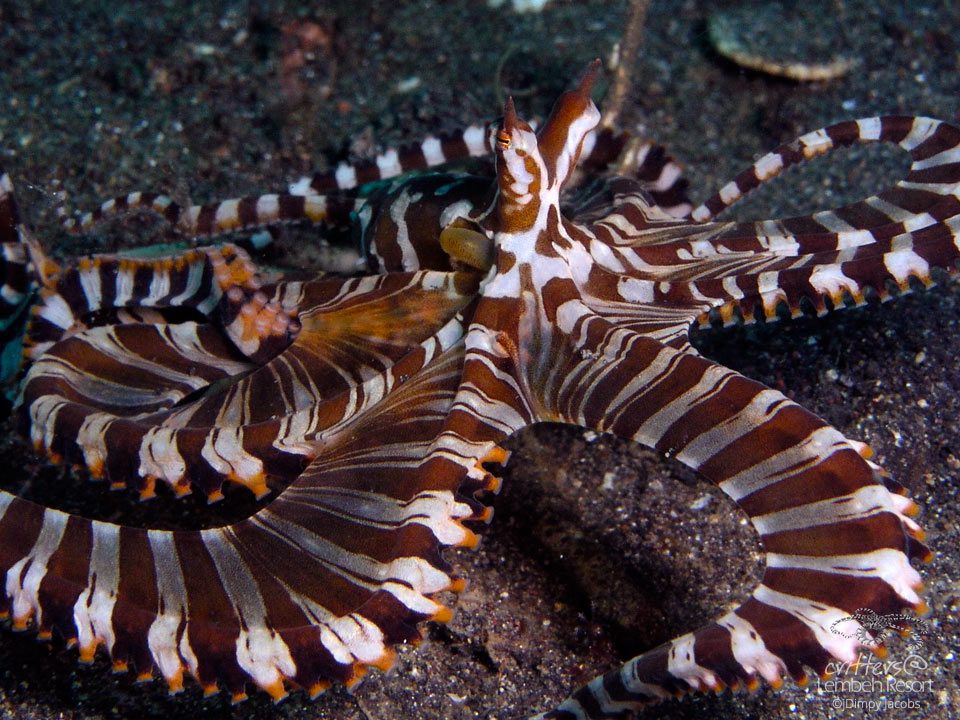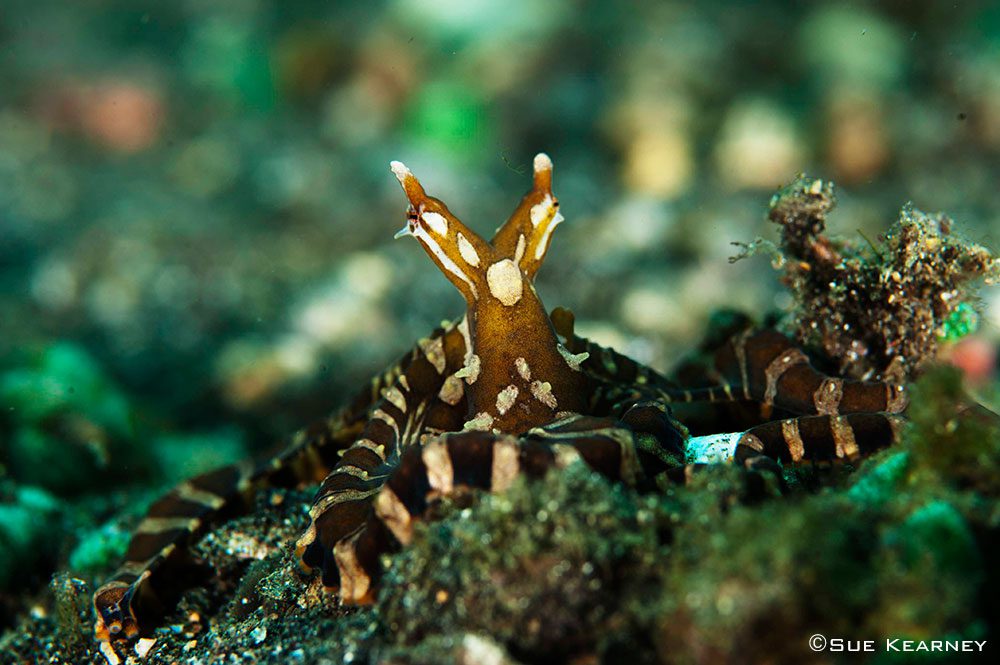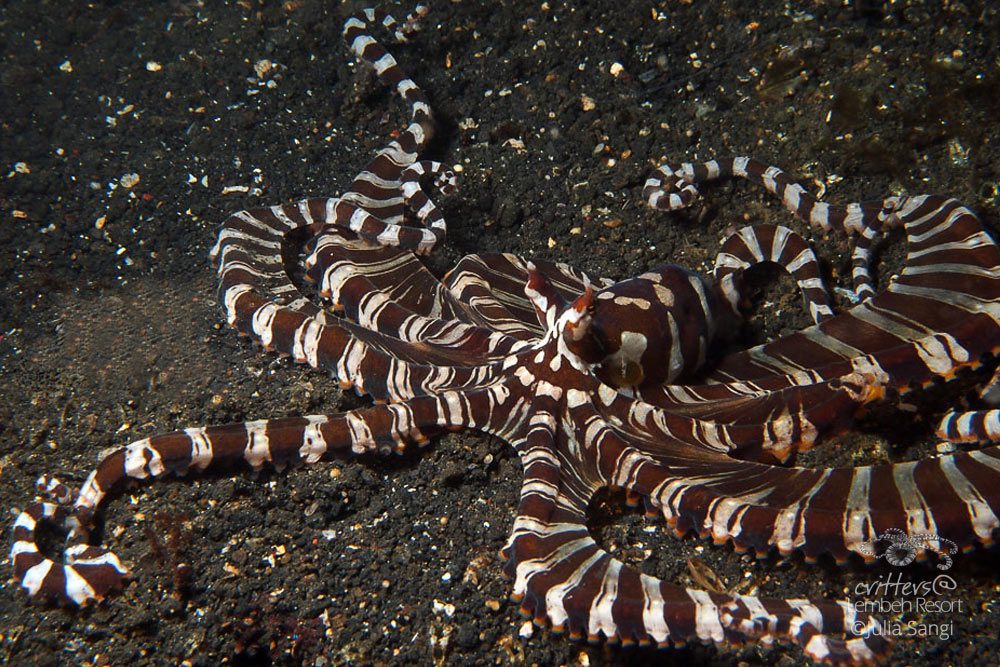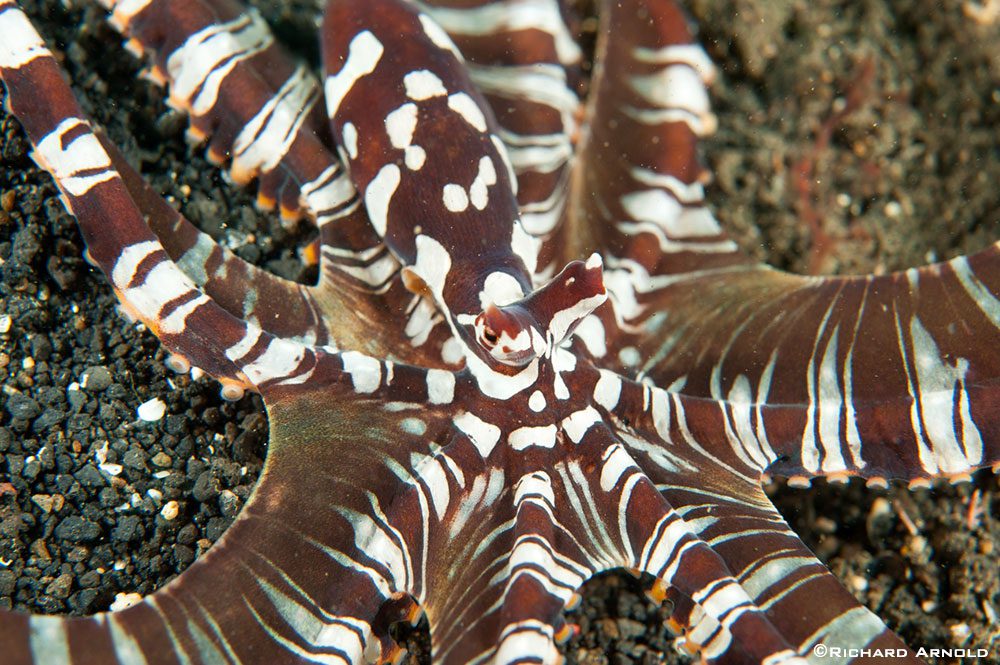Wunderpus Octopus: Masters of Mimicry in Lembeh Strait

The Lembeh Strait is renowned for the sheer abundance of rare and unusual marine life that resides here. The critters in the Lembeh Strait quite probably outnumber the amount of fish! Among the various critter types, cephalopods are particularly prevalent with numerous species of squid, cuttlefish and octopus to be found.
Octopi in The Lembeh Strait
Lembeh is home to multiple species of iconic octopi including (but not limited to) blue ring octopus, coconut octopus, algae octopus, hairy octopus, long arm octopus, starry night octopus, mimic octopus and of course, the wunderpus octopus. In this Blog we take a look at the wunderpus octopus in more detail.

Identifying Wunderpus Octopus (Wunderpus photogenicus)
The wunderpus octopus (AKA ‘wunderpus’) has a rich rusty colored body with white markings. It has a very similar physical appearance to the mimic octopus and the species are often mistakenly identified (see the comparison chart below). The white markings are found as ‘bands’ along their arms, underneath which are cream colored suckers. There are frequently other white markings on the wunderpus’ mantle, head and eye stalks.
Just like its close relative, the mimic octopus, the wunderpus is also able to mimic other sea creatures as a form of defence – and attack. Wunderpus are able to change their shape, color and skin texture in a split section to either blend in with the environment or to scare a potential predator away.
While the mimic octopus was officially recognized by scientists in 1998, it was not until 2006 that the wunderpus was officially recognized as a distinct species. Take a look at the table below to see some of the key differences between these two species.
Wunderpus OctopusMimic Octopus
Usually most active in the early morning and evenings
Usually active during daylight hours
Separation between dark and light areas of skin is distinct with high contrast
Separation between dark and light areas of skin is less distinct and more subtle / blended
Has an orange-brown, rusty skin coloration
Has a darker brown coloration (no orange hues)
Rear edge of mantle has a white spot
Rear edge of mantle has a white U or V shape
Has long eye stalks
Has more compact, shorter eye stalks
No white margin along the arms at the base of the suckers
Has a visible white margin on each arm at the base of the suckers

Wunderpus Octopus Diet
Wunderpus are predators that feed mainly on fish, crabs and shrimps (crustaceans). Like all octopus species, the wunderpus is known for its intelligence and it employs two different hunting methods according to the circumstances.
If it is hunting potential prey that is on the seafloor, it will use its camouflage abilities to approach the prey undetected. Once within striking distance the wunderpus will ‘stand up’ on its arms and position itself over its victim. Once in position, it expands the webs attached to its arms to form an ‘umbrella’ over the prey. It then uses a single arm to pull the prey into its mouth.
When hunting critters which are in burrows in the sand, the wunderpus will extend one of its arms into the burrow and grab the prey with the suckers on the underside of the arm. Incredibly, the wunderpus has the ability to regenerate parts of its arms that are lost and it can also release these parts to distract predators.

Wunderpus Octopus Behavior
Because the wonderpus octopus was discovered relatively recently, and prior to this had been believed to be a mimic octopus, there is not a wealth of information available regarding its habits. However, it is thought that the bright rustic body color contrasting with the white bands enables this species to mimic dangerous banded animals like sea snakes and lionfish as a form of protection against predators.
Another theory suggests that it might be a warning to predators that it’s toxic – supported by the fact that the colors and pattern become even more highly contrasted when the creature is threatened.
The Ideal Home for the Burrow-Loving Wunderpus
Wunderpus live in burrows – which makes the Lembeh Strait the perfect habitat for them. Lembeh’s fine volcanic black sand sites make burrowing easy. The wunderpus will not always dig its own burrows though, it will also move into burrows dug by other species, including other octopuses. Wunderpus venture out of their burrows to feed at both dusk and dawn – making these the best times for wunderpus sightings.
Wunderpus move around by either streamlining their bodies and swimming or by using their arms to raise themselves up and perform a walking motion over the ocean bottom.

Wunderpus and Underwater Photography
Wunderpus are extremely fast swimmers and they are quick to take flight when threatened. The best photography of wunderpus will have the eye clearly in focus, be well lit to show the rich coloration, and have a crisp overall focus to show the white markings.
The best time to capture a wunderpus shot is when the creature is stationary on the sand. Approach extremely slowly and in increments, allowing the octopus to get used to your presence before closing the gap between you again.
Take shots while edging closer and keep adjusting your focus. By doing this, if the wunderpus takes flight, you should still have some usable shots.
At Lembeh Resort, our underwater photography equipment & accessories service provides high-quality macro lenses, dedicated focus lights, and underwater camera housings to help you nail those perfect shots.
Your Perfect Underwater Photography Journey with Lembeh Resort
Lembeh Resort isn’t just a dive destination, it’s a photographer’s dream come true. Let us be your partner in capturing the magic of the wunderpus. We are the only dive resort in Lembeh that has photography-trained Dive Guides, a designated camera room, a full-service Photo Center, and an onsite full-time Photo Pro to provide you with guidance and assistance.
Ready to dive into the wonders of Lembeh Strait? Contact us at reservations@lembehresort.com or browse our rates and let us guide you on your underwater photography adventure of a lifetime.
Discover more critters in Lembeh Strait
If you enjoy reading about the fascinating marine life found in the Lembeh Strait, you may also enjoy reading:



